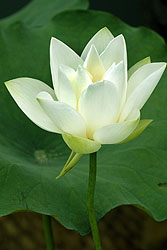
|
|
| White Lotus - Nymphaea ampla - Mexico, Yucatán, Mayan culture |
|
The white water lily, or Nymphaea ampla, grows thick rhizome and has long-stemmed cordate leaves. Its white flowers jut up about four to five inches above the plant’s floating leaves. The plant occurs throughout the Mayan lowlands in southern Mexico. It is also found growing wild on the higher elevated lake plateaus of Chiapas. It’s also commonly found in the natural wells, limestone and caverns near Merida in the northern Yucatán, and in Lago Peten Itza in Guatemala, and is said to occur in Brazil. Its rhizome can be multiplied and thrive when placed in a pond with drainage or in slow-moving water. It was first described scientifically in the nineteenth century. The earliest reports of its psychoactive use began to appear in the 1970s. A very common subject in Mesoamerican art, the rain god Theotihuacan was often depicted with water lily leaves, buds and flowers – most often with water lily buds in his mouth. This has lead some ethnomycologists to interpret these images of water lilies as representations of entheogenic mushrooms. The water lily was often found portrayed in an iconographic context in the art of the classic Mayan period. One can interpret these appearances of the water lily in a variety of ways. In essence, there are three motifs: Water lilies sprouting from the backs of crocodiles, their powerful jaws grazing the surface while swimming in the water; the head of the “earth monster,” around which water lilies are entwined; and jaguars (the animal symbol of the shaman), either wearing the stalks and buds of water lilies as head ornaments, or dancing with water lilies. The association between the water lily and the jaguar is especially dominant during the Mayan period. The water lily is often found on ceramic vessels that appear to depict, for the most part, prophetic scenes from the underworld or other worlds. The main use for these containers is believed to be the delivery vessel for the magical, ceremonial concoction known as the balche’ drink of the priest or shaman. Balche’ is the potion which helps the holy man change into his transformation animal on his way to the other world. Less frequently seen portrayed is the transformation of tadpoles, with the tadpole changing his form to become a toad; the shaman undergoes a similar transformation and manifests himself into his animal alter ego. In some depictions, the toad is seen in human form, offering libations to the jaguar; these libations may consist of balche’ to which the water lily appears have been added, to invoke shamanic ecstasy and make the shaman’s transformation easier. There is a Mayan hieroglyph known by the name “Jaguar-Water Lily” which has played an important role in the deciphering of the Mayan writing system. In all likelihood, the jaguar-water lily is a transformed shaman. In the American tropics, the jaguar is the most important shamanic animal, and is the animal that is identical to the shaman whose shape he can assume. A very famous uay glyph from the classic Mayan period depicts a jaguar appearing to be inebriated, swimming in a lake alongside Mayan symbolic text which reads: “Water Lily – Jaguar – His Naugal – Seibel – Alau”; loosely translated this means “The lord of the city of Seibel has the water lily as his nagual.” “Naugal” in Mayan refers to a shaman’s animal transformation, “alua” means lord and “uay” means magic and transformation. This uay glyph may indicate that the shaman was transformed into a jaguar by means of the potent balche’ drink and is traveling in another reality. The iconographic element of the water lily may be interpreted in numerous ways, all related: as a symbol for the balche’ drink, the water in which the inebriated jaguar swims, the inebriation itself or the other reality. The water lily is also depicted as a ritual scepter, many hovering over balche’ vessels. There are many graphical iconic examples that lead one to the conclusion that Nymphaea ampla appears to have been used as an additive to the balche’ drink used in religious ceremonies by priests and in shamanic ritual ceremonies by shamans. It has been reported that the flowers were used as a narcotic inebriant with opium-like effects during the first half of the twentieth century in Brazil. Throughout the 1960s, white lotus flowers were said to have been used as a recreational drug. The effects of the flower when prepared as a tea or decoction and ingested are said to be much like the opiate apomorphine. White lotus actually contains aporphine, which is closely related to apomorphine, differing only in the lack of two hydroxyl groups. It is very likely that is can be transformed into apomorphine through processing, storage or through one’s own metabolism. There are many who report feelings of floating and euphoric sensations after ingesting a potion made from the white water lily. The dried buds and flowers can be smoked alone or in smoking blends. One to two buds is said to be a successful psychoactive dosage. The fresh rhizome can be eaten raw or cooked. Eating an entire rhizome has been documented to produce a mild sense of euphoria. The water lily was invoked in numerous Mayan magical conjurations to heal ulcers and skin diseases. Many reports from modern-day Yucatán describe the use of the plant for ethnomedicinal purposes. FIND MORE ON WHITE LOTUS AT SHAMAN'S GARDEN. |
|
Related
Articles :
|
|
| Email
This Article To A Friend - Print
This Article Articles can be E-mailed to a friend and you can get a printable version of the article IMPORTANT: We provide all information for educational purposes only, and endorse or recommend nothing here. A special thanks to Keith for all his support and insight. |
|
